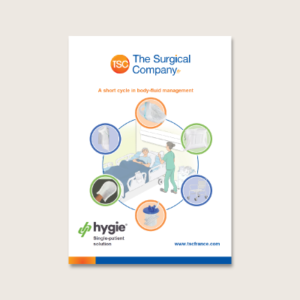Combating the spread of
HAIs with Hygie’s
Single-Patient Solution
What is a Healthcare-associated Infection?
Healthcare-associated infections (HAIs) or nosocomial infections are infections acquired by patients in healthcare settings during their stay for other conditions and include infections caused by the following:
- Clostridioides difficile (CDI), methicillin-resistant Staphylococcus aureus (MRSA), Carbapenemase producing organisms (CPO), or other bacteria and viruses encountered in healthcare facilities
- infections associated with the devices used in medical procedures (such as catheters or ventilators)
- Infections occurred at surgery sites (surgical site infections) 1
How is it transmitted?
HAIs require a source of infecting microorganisms, a susceptible host, and a means of transmission for the microorganism to the host, and can be transmitted via these means:
- Contact Transmission: Through direct contact between an infected patient and a susceptible patient or healthcare worker
- Respiratory Droplets: Droplet-sized body fluids propelled directly to a susceptible person or a shared environmental surface
- Airborne Spread: Microorganisms that can remain suspended in the air for lengthy periods
- Common Vehicle: Multiple people are exposed to a common contaminated vehicle (eg. A shared device or equipment) 2
Impact on Canadian Healthcare:
HAIs negatively affects healthcare settings and infection prevention and control professionals (IPAC) in terms of costs and resources. Being infected with an HAI can increase the risk of morbidity and prolong hospital stays due to the extra treatment, lab tests, medications, isolation supplies, cleaning, laundry, and nursing and physician care that is required, further burdening a healthcare setting’s already limited resources3. It is estimated that 220,000 Canadian patients (approximately 1 in 9)4 will develop an infection during their stay in hospital and can exacerbate the problem when it is caused by antimicrobial-resistant organisms (AROs)5. According to Infection Prevention and Control Canada (2021)6, Canada continues to see gaps in gathering and reporting national trends, which makes it difficult in identifying emerging pathogens, monitoring trends in HAI, and establishing benchmarks that will inform activities on how to prevent the spread of HAIs.
Study of Effectiveness of Single-Patient Support in Reducing the Spread of Bacteria
In Meunier, Populus, Durrheimer, Duffet & Burger’s (2019) study comparing traditional bed pans and single-use supports at Sandrine Burger Hospital, it was determined through consultation and multidisciplinary analysis “that change-over to a complete system of individual-patient supports and single-use bags with gelling agents is financially, ecologically, ergonomically, and hygienically advantageous, including in terms of patient comfort and task simplification for orderlies.”7 When administering Hygie’s Single-Use Solution, it became clear that this offering provided a management system that was simple, realistic, effective, and carried no risk of dispersion of patients’ stool as patient stool is a significant reservoir of MARB and eXDR, C. difficile spores and other enteroviruses.8
Hygie’s Single-Patient
Body Waste Management Solution
1“About Healthcare-Associated Infections.” Provincial Infection Control Network of British Columbia. Provincial Infection Control Network of British Columbia. Accessed January 24, 2023: https://www.picnet.ca/surveillance/about-hai/
2Collins, A.S. (2008). “Preventing Health Care–Associated Infections.” Patient Safety and Quality An Evidence-Based Handbook for Nurses. Rockville (MD): Agency for Healthcare Research and Quality (US).
3Graves, N. (2004). “Economics and preventing hospital-acquired infection.” Emerging Infectious Diseases Vol. 10(4):561-566; Gould, I.M. (2006). “Costs of hospital-acquired methicillin-resistant Staphylococcus aureus (MRSA) and its control.” International Journal of Antimicrobial Agents Vol. 28(5):379-384.
4“About Healthcare-Associated Infections.” Provincial Infection Control Network of British Columbia. Provincial Infection Control Network of British Columbia. Accessed February 10, 2021. https://www.picnet.ca/surveillance/abouthai/#:~:text=HAIs%20are%20a%20major%20patient,in%20at%20least%208%2C000%20deaths.
5Infection Prevention and Control Canada. (2021). “A Written Submission for the 2022 Federal Budget from Infection Prevention and Control Canada.” Accessed January 24, 2023: https://www.ourcommons.ca/Content/Committee/441/FINA/Brief/BR11510780/br-external/InfectionPreventionAndControlCanada-e.pdf
6Infection Prevention and Control Canada. (2021). “A Written Submission for the 2022 Federal Budget from Infection Prevention and Control Canada.” Accessed January 24, 2023: https://www.ourcommons.ca/Content/Committee/441/FINA/Brief/BR11510780/br-external/InfectionPreventionAndControlCanada-e.pdf
7Meunier,O., Populus,G., Durrheimer, J., Duffet, B., Burger, S. (2019). “Single-use: an interesting alternative to bedpan washers”.
8Meunier,O., Populus,G., Durrheimer, J., Duffet, B., Burger, S. (2019). “Single-use: an interesting alternative to bedpan washers”.


